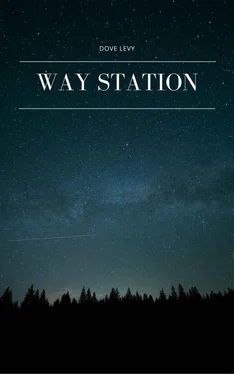I don’t know why this place has a skylight. There are no stars to look at.
Dr. Eve Strauss, Research Facility B on the southern continent of Way Station, assisted by Dr. Isaac Federman. Walls are intact and the life support system is running at optimal capacity. Food storage and air supply are clean. All members of the research team were found in the excavation areas surrounding the facility, at least one in each area except for 11a, 11b, and 13. No signs of struggle found either within the station or where the bodies were located.
Examination review of Aiko Hamasaki, ID number 916, details in file. Full autopsy report in temporary file, pending transfer when communication channels open again. They were found standing, clothed, and in their walking suit, standing in the pit of excavation site 3. Cracks cover their helmet and pieces of the helmet have fallen out, and tears were found in numerous places on their walking suit, mostly in the front and above the waist.
Lacerations line their face and beneath each tear in their suit, with additional cracks spreading over the skin from them. Their body is frozen and solid from minerals. Samples taken suggest petrification like that of the trees on Way Station, a very sudden change that cannot have taken more than a few seconds. Logs taken from the facility show a storm passed through at the time of death, carrying vast amounts of dust and minerals with it, not flung fast enough to pierce the walls of the facility but fast enough to tear through the suits of the research team. Pressure must have been exceedingly high within the storm to have compressed the rock so quickly as to petrify them before they fell.
Cause of death is natural and caused by the storm. All members of Facility B are deceased.
* * *
Three days is a good length of time to work through your issues, especially when you don’t really have much else to do. At least, it’s enough to get me to stop feeling sorry for myself.
Dr. Federman tried to help, though I don’t know if it was him telling me, “A report stating an unidentifiable alien virus is more than useful for those back home,” that cheered me up or if riding in a cramped car on a bumpy road the headlights couldn’t light more than a few feet of kept me sufficiently distracted for long enough that I no longer cared about it.
Sleeping in a car during road trips is bad enough when you’re surrounded by loved ones, after long days of driving through picturesque scenery and stopping at gas stations that feel like their reality is just slightly out of sync with the rest of the world. It’s worse when the car isn’t a van, you have to sleep in your space su… — walking suit, still not used to that term — you have to sleep in your walking suit in case the door gets opened somehow, and you’re stuck cuddling with someone you haven’t had conversation with that didn’t involve work in the few months you’ve known him because there was only one blanket and the back seat wasn’t even large enough for one of us to stretch out in.
Facility B feels like it would be a stop on a road trip, though, if ever POGE becomes a tourist destination. From what little the facility lights have illuminated, it’s one of those Grand Canyon-esque places. The surrounding area is a desert wasteland, a few trees here and there that were already stunted before they were ever petrified, and manmade pits pockmark the land between the natural valleys and canyons. We’re right on top of a fault line, too, and if I remember anything from my short stay in California, people just love to build their homes where the earthquakes will be.
Walking into the facility felt like entering a museum, and when I leave the bedroom or the examination room, it still takes me a moment to remember that people actually lived their daily lives here for years. Everything is spotless and organized, not a piece of equipment out of place, unlike Facility A, which was covered in forgotten clothing and dishes and actually felt lived in. Even the displays here have signs at the base and velvet ropes surrounding them, as if any of the team members wouldn’t know what they themselves had discovered, or would forget not to touch them. I think it was their way of having fun.
I’ve never seen skeletons like this. Or, shapes, I should say. They don’t quite look like skeletons, though they also don’t look like bug shells. They flow and twist like liquid frozen in movement, colors ranging from the bleached white of desert bones to a mosaic of pinks and greens and yellows. I can’t tell where the joints were supposed to be, how the flesh could fit over those bones. It was never an exact science, even in dinosaur exhibits on Earth, but at least those had a similar enough structure to the animals that do still exist that some pretty educated guesses could be made.
I can’t even tell if these things had heads. I tried looking into the team logs, but they only had speculation too.
It’s weird to think that there were animals here, however long ago it was. POGE once had solar-based life similar to that on Earth. It couldn’t have taken long for that all to stop when it was kicked out of its old solar system, but looking at these remains, sizes ranging from barely ankle-height to nearly scraping against the enormously tall ceilings, it makes me feel like they’re still right outside, like some of them survived.
The only life on this planet that hasn’t gone extinct are the chemoautotrophs, microscopic and making hardly a difference with no prey or predators, clustered around deep sea vents and not really going anywhere else. That’s not as exciting.
— — —
I recorded that before beginning the examinations, before Dr. Federman and I had spent the past few hours retrieving frozen team members from their standing graves. When you experience something, you should record it, he’d told me. It wouldn’t matter much to do it when the memory has started to fade.
I would like to return to my earlier amazement.
This time, I have sure knowledge in what killed them. That, at least, feels nice. The lack of an answer for my first assignment didn’t give me very much confidence in how well I would perform for the next few months, so certainty is a blessing.
Human motivation, though, can be very hard to figure out once they’ve already died, and that’s what’s eating away at me.
It would be normal for a few of them to be outside at any given time. Despite how enjoyable their jobs could be, they were still jobs, and these teams had full 24-hour schedules taken in shifts so there was never not somebody awake and working. Maybe one or two of these pits would be worked in at a time, probably those farther out that hadn’t been worked in as often as the ones right outside the facility.
But every single team member was outside. 23 of the excavation sites had at least one occupant. Nobody manned the communications channel, nobody worked in the kitchen, nobody slept. They were all outside. They were all outside with not a tool in their hands, facing the same direction, standing straight and tall without a hint of movement.
Weather patterns to a distance of 50 miles are automatically logged in the system, warnings given when they seem to be growing dangerous or heading towards one of the facilities. These warnings include the estimated size and velocity of objects within the storm, and are loud and blaring and there is no way to ignore them. From what the logs say, these warnings came to Facility B approximately an hour before the storm hit.
And yet, everyone was outside and facing it when it did.
Some of the rocks within the storm were as large around as my head, blown more than fast enough to crack someone’s skull, but at these speeds, everything bigger than gravel pebbles would easily shred our walking suits. It’s no wonder they all turned out like they did. The storm must have dissipated by now, but not before falling onto a path in line with our next stop at Facility C and then curving around the outskirts of E. There were no distress signals sent out from either of those locations, signals which would have reached all stations on the southern continent, but then, there were none from Facility B, either.
Читать дальше












